We have always maintained that the land and flock must feed us. We’re not farming for money, or hobby. Our aim is and has always been to produce good food from the land we live on, for ourselves and to share with our local community—our neighbours, friends, and family. Funny how that’s seen as a lifestyle choice and not just the necessary work of obtaining food and living as people have always lived on the land. Isn’t it something that we have the choice to leave the land and the growing, harvesting and preparing of food to someone else and not give a thought to where our sustenance comes from? But that’s not to say that we’re dependent on it—no more than every one of us is dependent on the land and somebody working it to grow our food—we live in a developed country in a time when living on the land is a choice, and one we work hard for. For full transparency my husband works full time off the farm to put a roof over our heads and clothes on our backs, and I make a little from my wool crafts and writing these stories while I run the farm. We don’t claim any farm subsidies, and the little bit we make back directly from the farm in occasional meat boxes and duck egg sales only offsets some of the costs of producing them. Every year, we dutifully run our farm accounts and every year we run at a substantial loss. We could leave the land to the wild or the real farmers (we don’t know any who don’t also have off-farm jobs to keep bread on their own tables while their farms barely break even, but that’s a rant for another day) and live a lot cheaper and easier on factory packed meat grown on someone else’s land, fed on soy from far off lands, and imported groceries from the supermarket. It’s a crazy world. Anyway, call it farmsteading, smallholding, or whatever. I prefer “sufficiency farming”—working with the land we live on to produce what is sufficient to live and share locally, on a human scale, within the perimeters of our landscape, climate, and local resources.
The land we farm is not arable. It’s wet, rugged and rocky, high and exposed. Our climate is wet. Wildly wet. I mean, you haven’t seen rain until you’ve seen west of Ireland rain kind of wet. And our growing season is relatively short and unreliable. Not much grows up here on our rocky, exposed, hill land in our wildly wet, North Atlantic, oceanic climate besides heather, rocks and hill sheep. The real farms surrounding us are hardy beef sucklers (that’s cows rearing calves on pasture, until they’re weaned to be grown on for beef) and sheep running on permanent pastures, hill and heath. Down in the valley lowlands the pasture is good enough for dairy, but even on the best soils, the climate here in the south-west of our little island of Ireland is still too wet and unreliable for grains or protein crops. Vegetable crops that are grown on commercial scale are limited to fields of turnips, carrots, spuds, cabbage and kale—the makings of traditional Irish fare: bacon or corned beef and cabbage, mutton stew, boiled spuds with butter—the foods that have reared generations of strong Irish men and women. The foods that grow here (once upon a time every homestead would’ve raised a pig or two to fatten on waste spuds and windfall apples and in turn become the bacon, and a goat or a cow for milk and butter). Some years it’s even too wet for turnips. A few small scale commercial producers grow exotics like courgettes and lettuces in poly tunnels. Every homestead grower has a poly tunnel.
The only plant food crop that might do well enough on the hill land we farm are blueberries, and maybe hazelnuts. We could grow acres of blueberries and sell them for money and buy our staple foods from elsewhere, but we can’t live on blueberries, or hazelnuts. But sheep grow well here in these hills, and sheep we can live well on as the mainstay of a simple, local, homegrown diet (perhaps supplemented with a few blueberries), plus they give us wool and hides which I can up-value into artisan crafts to sell or gift. So, sheep we shall eat, and so sheep are the mainstay and crux of our farm
Even down here on our new, little homestead, a few acres set into a dip in the hills, sheltered and green, it isn’t arable land. It’s wet pastures and old woodland on rock. There are pockets of good enough soil and sunlight exposure for fruit orchards and a small vegetable garden, room for a poly tunnel to grow our own peppers and tomatoes, but mostly it’s low-lying, shallow soil on a heavy clay pan prone to floods off the hills, with higher rock outcrops covered in old growth holly and oak; it’s beautiful, permanent rush pasture and old woodland, where jays build their nests among the oak and mistle thrushes and redwings flock to feast on scarlet holly and honeybees hum through thickets of bramble and ivy. It’s perfect for goats. So, of goats we shall eat.
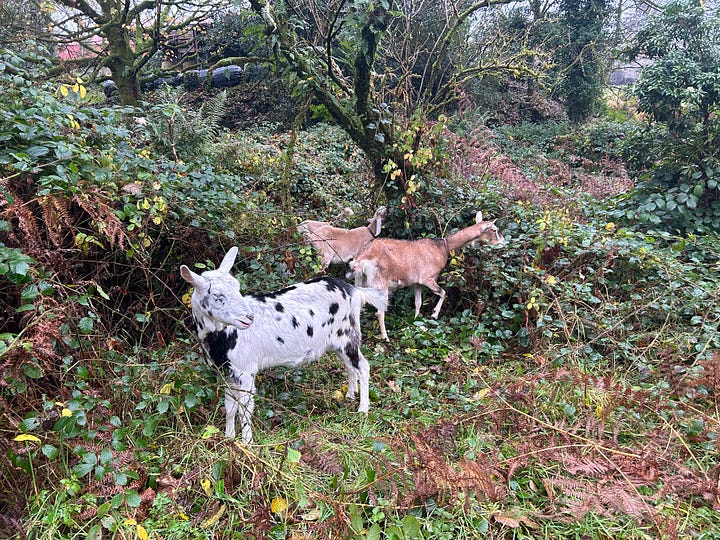

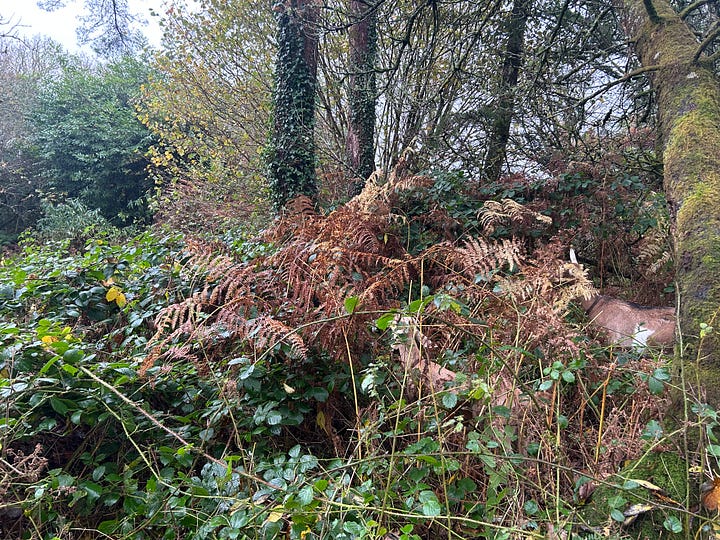
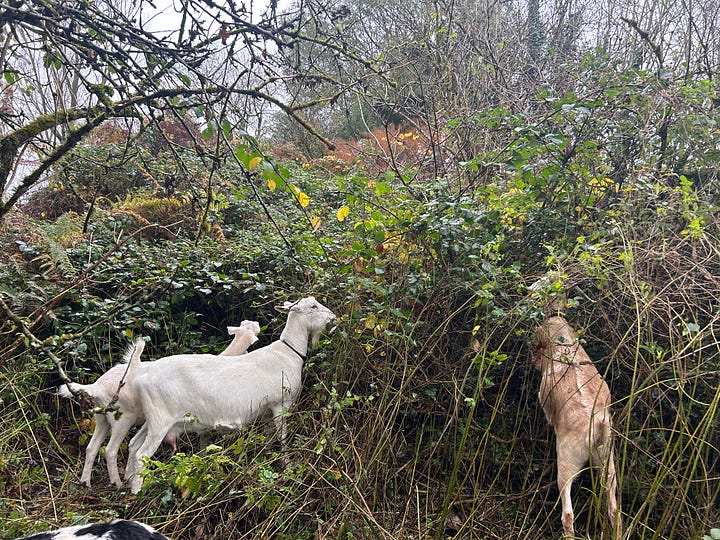

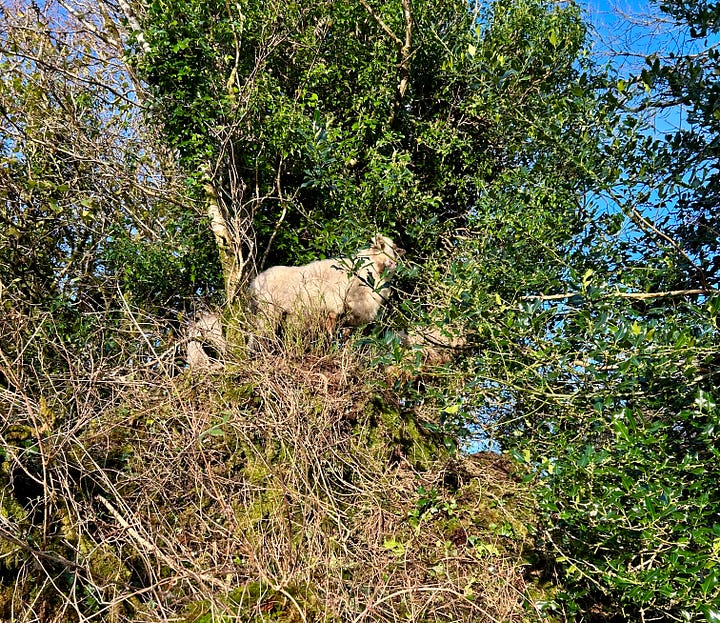
We have also aways maintained that to make the best use of our resources the animals we keep must have dual purpose. Our sheep provide meat and wool. Years ago we used to milk them, too, but dairy sheep won’t do up here on our rough, hill land so we replaced them with hardy hill breeds that give exquisite meat grown of heather and gorse and beautiful fleeces made for the rain. And we have goats for milk and meat. Goats are more efficient than either sheep or cows at converting rough forage—scrub, heather, rushes, rough grasses and tree forage—into milk. Animals that will feed us and thrive on our land of wet, rough pastures, hill and heath, of breeds that are thrifty and suited to produce well in the land and climate, without a lot of inputs besides hay in winter that we buy locally, when the land is too wet to leave animals out and grass growth has stalled.
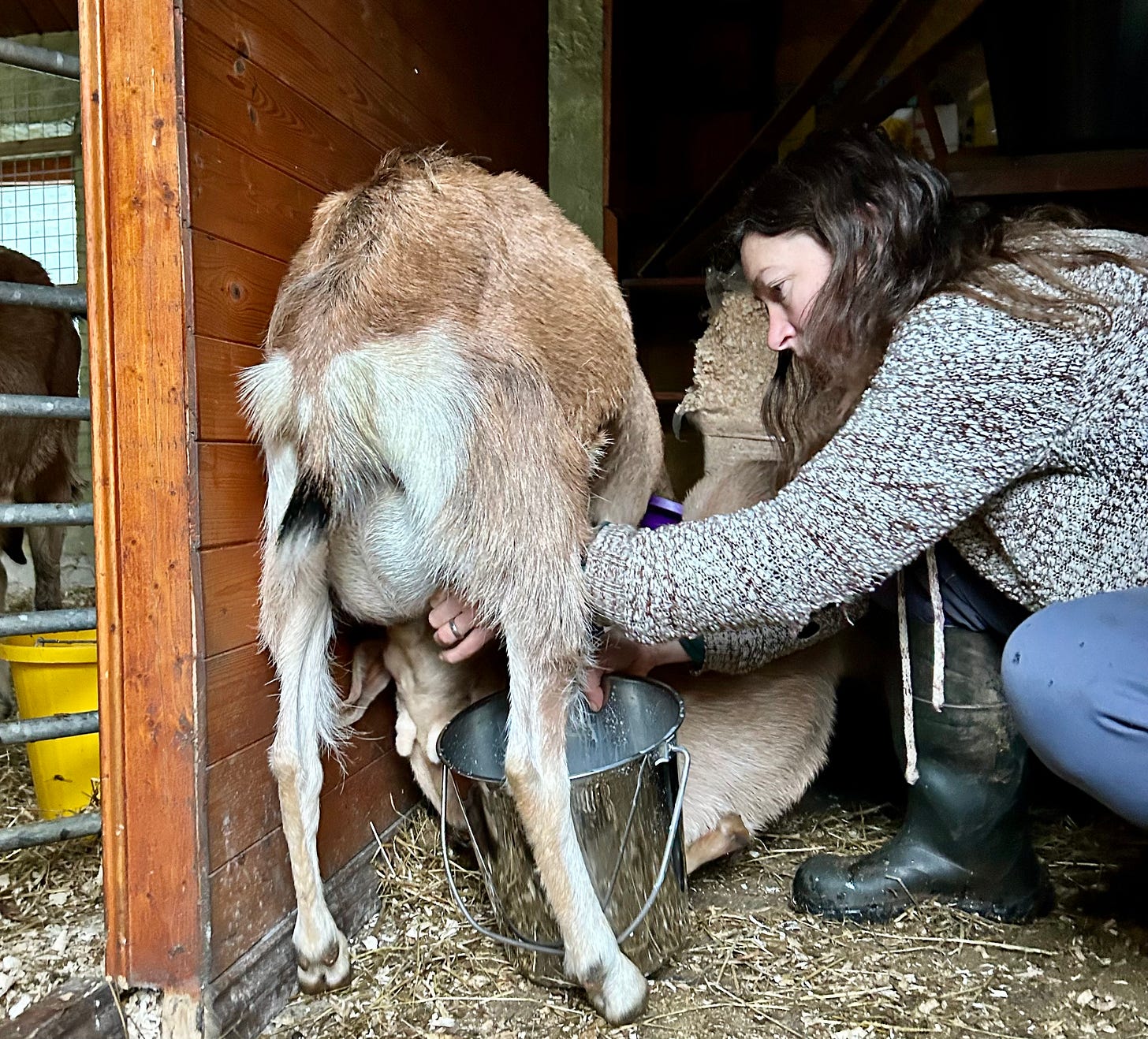
It’s in this darkening, transitional season when the forage falls back and animals are rutting and restless and getting hungry, the approach to deep winter, breeding season, the season of hard decisions and harvest, when we fall back on our fundamental reasons for choosing this life and doing what we do. Summer is too easy to make the tough decisions on numbers, when the grass is high and we can forget about the sheep out on the hill and everyone is fat and gleaming on summer’s abundance. It’s now, when the land is retreating into winter, when we have to take a hard look at what’s working for us and what isn’t. What we need to do differently next year. Which animals make the mark to be bred or held over a winter of feeding expensive hay, and which would better serve their purpose in our freezer, or shared as meat boxes to our community to make space and free up resources for the rest of the flock. How much hay can be bought of the quality needed, given the variabilities of the season? Nothing is stable or certain from one year to the next and we have to adapt and adjust with each season. This year was bad hay year. Our usual source let us down. We can source quality, organic wrapped bales from another supplier but at more than double the price. How many animals can we afford to winter at double the cost? How many can we fit in our freezers? How many meat shares can we sell or trade? Which sheep? These decisions get harder every year.
This year we’ve made the decision to not breed any sheep. The flock has become too many for the land and we have been too soft and reluctant to make the necessary reductions. We have enough ewes marked for mutton to see us through the next two winters, gradually reducing the flock to a number that we can comfortably maintain in balance with the land, wool for my crafts being our main crop, then breeding a few ewes each year for just enough lambs to fatten on the summer’s grass. And we have enough going on this year without adding a month of sleepless nights and all the preparation and stress that comes with lambing.
We’ve got one goat kidding in December (her decision, not mine), and four more through March and April. That’s enough. We’ll have plenty of kid meat to supplement the mutton in our freezers next year, and milk enough to run a small creamery. Milk from mother goats who rear their own kids and have plenty to share, made of brambles and wild roses and rain.
We’ll add other animals to diversify and make better use of the land and resources now available to us. Maybe a couple of little kune kune pigs to pasture in the orchards and grow fat on the windfalls, to turn and manure the soil for next year’s veg patch while they’re laying down the bacon fat. A few geese to follow the sheep over the pastures, fill our feather quilts and grace our tables at Christmas. Our ducks will do the work of slug patrol around the gardens, and convert those slugs into eggs and duck meat. Dual purpose, filling a niche on the farm, working with the land, climate and local resources to feed us from the land we live on.




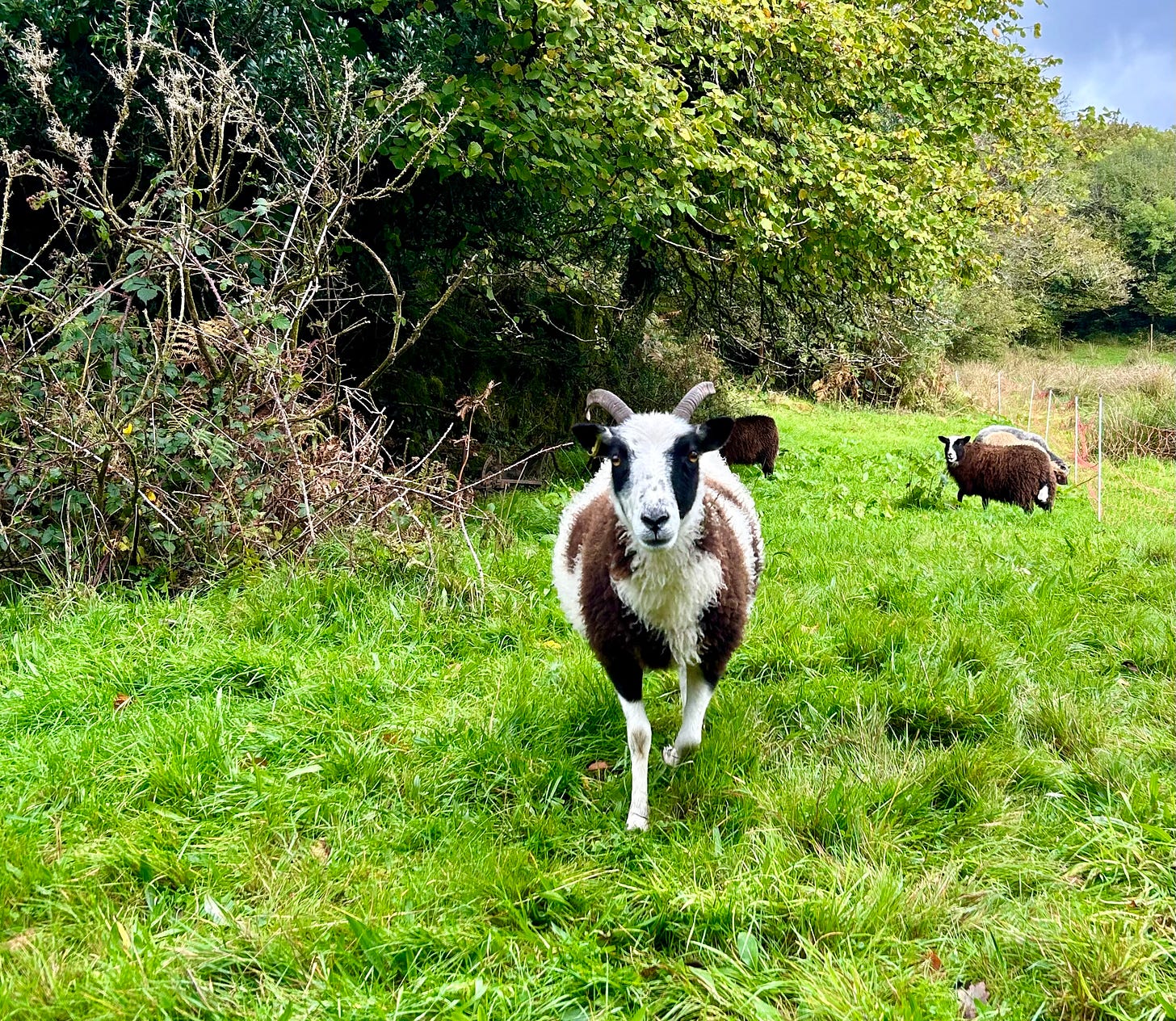

Ps stay safe during storm Bert!
Most of us don't realise about the hardships of running a farm and tending livestock, you have some tough decisions to make and I guess that each day you must feel exhausted from all this work.